What are sideline out of bounds plays
Sideline out of bounds plays are comprised of one offensive player that will inbound the basketball by standing near a sideline and four additional offensive players that will execute actions such as basketball cuts and basketball screens to generate potential scoring opportunities at the rim, near the mid-range, or beyond the three-point line.
What are examples of sideline out of bounds plays from a box set
Example 1 – Part 1
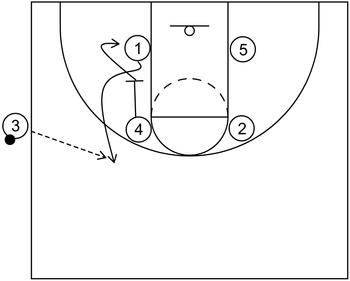
This is an example of a sideline out of bounds play derived from a box set formation. To begin, 1 cuts to the left side wing area via the down screen set by 4.
Also, after setting the screen, 4 fills the recently vacated left side low post block. Following that, 1 receives the ball from 3.
Example 1 – Part 2

Next, 5 cuts to the top via the down screen set by 2, which is also a ram screen for this case. After that, 1 dribbles towards the right side wing area via the on-ball screen set by 5.
Also, as that action occurs, 3 executes a baseline cut from the sideline towards the right side corner via the screens set by 2 and 4.
Furthermore, 2 fills the left side low post area while 4 pops out to the left side wing area after setting the screens.
Meanwhile, 3 receives the ball from 1 and can take the three-point shot if open.
Example 1 – Part 3
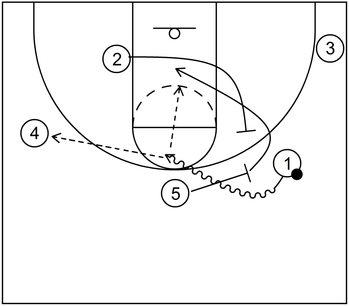
If 3 is not open to receive the ball, then 1 could dribble towards the middle via another on-ball screen set by 5.
Additionally, 5 could receive a back screen from 2 and then roll to the basket, which is essentially the Spain pick and roll action.
From there, 1 could take the mid-range shot if open, 5 could receive the ball near the basket, or 4 could receive the ball for another possible three-point opportunity.
Example 2

This is an example of a basic sideline out of bounds quick hitting play initiated from a box set. To start, 1 cuts near the left side wing area via the diagonal screen set by 5.
Next, 1 receives the ball from 3 and afterwards, 1 begins to dribble towards the top. As that dribble action occurs, 3 cuts to the right side wing via several screens set by 2, 5, and 4.
From there, 3 receives the ball from 1 and could take the three-point jump shot if open.
Example 3
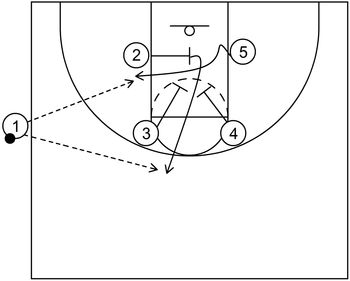
This is an example of a sideline out of bounds play initiated from the box formation with two simple scoring options. To start, 5 cuts across the lane to the left side low post block via the cross screen set by 2.
Immediately following that cross screen, 2 cuts to the top via the elevator screen set by 3 and 4. After that, 5 could receive the ball from 1 and score near the rim with a low post move.
Alternatively, 2 could receive the ball from 1 and take the three-point jump shot if open.
What is an example of a sideline out of bounds play from a stack set
Part 1
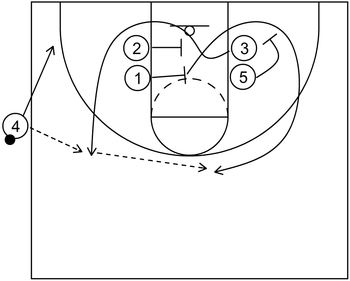
This is an example of a sideline out of bounds play from a stack formation. To begin, 3 cuts to the left side wing area via the double screens set by 1 and 2.
Next, 3 receives the ball from 4 and as that occurs, 1 cuts to the top via the down screen set by 5. Afterwards, 4 could fill the left side corner and 1 could take the three-point shot if that is open.
Part 2
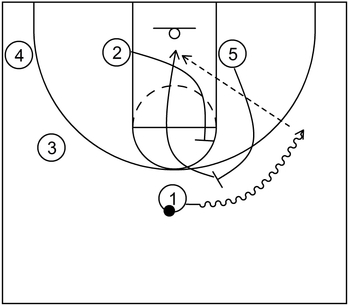
If 1 is not open to take the jump shot, then 1 could dribble towards the right side wing via the on-ball screen set by 5. After setting the screen, 5 could roll to the basket via the Spain back screen set by 2.
Following that, 5 could receive the ball from 1 and score at the rim with a layup or dunk.
What are examples of sideline out of bounds quick hitters
Example 1
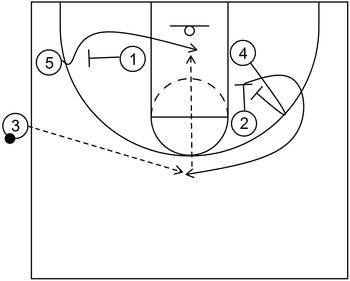
This is an example of a sideline out of bounds quick hitter which includes a three-point play as well as a scoring option near the rim. To start, 4 begins to cut towards the perimeter via the pseudo-down screen set by 2.
However, once 4 is below the down screen, 2 cuts to the top of the key via the actual down screen set by 4. From there, 2 could receive the ball from 3 and take the three-point shot if open.
If that is not open, then 5 could cut to the basket via the flex screen set by 1, receive the ball from 2 via the high low pass, and then score at the rim.
Example 2

This is an example of a simple sideline out of bounds quick hitter which features high low action near the basket. To begin, 1 cuts near the left side wing via the screen set by 3.
Afterwards, 1 receives the ball and when that occurs, 4 executes a flash cut near the left side high post elbow. Next, 4 receives the ball from 1 and then 5 cuts into the lane.
Following that, 5 receives the ball from 4 and scores at the basket with a layup or low post move.
Example 3
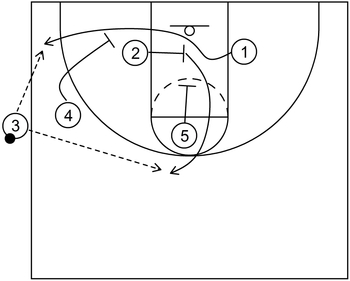
This is an example of a sideline out of bounds quick hitting three-point play. To begin, 1 cuts to the left side corner via the baseline screens set by 2 and 4.
As that happens, 2 cuts to the top via the down screen set by 5, which is also screen the screener action as well. Following that, 1 or 2 could receive the ball from 3 and then take the three-point jump shot if open.
Example 4
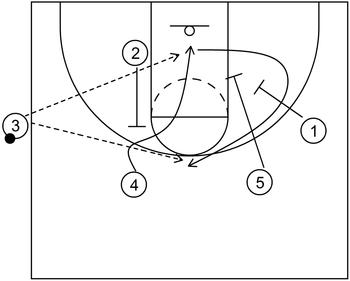
This is an example of a sideline out of bounds quick hitter which features two scoring options. To start, 4 cuts to the basket via the back screen set by 2.
From that point, 4 could receive the ball and score at the rim if that is open. Otherwise, 4 could cut back to the top via the stagger screens set by 1 and 5. Afterwards, 4 could receive the ball from 3 and take the three-point shot if open.
Example 5
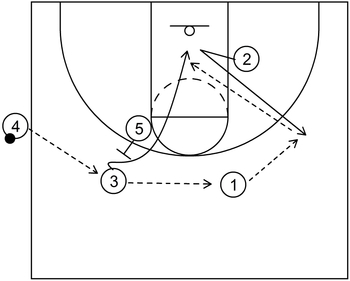
This is an example of a sideline out of bounds quick hitter that is reminiscent of the Shuffle offense. To start, 3 receives the inbound pass from 4.
Afterwards, 1 receives the ball from 3 and as that occurs, 2 gets open with a v-cut to receive the ball from 1. Next, 3 executes a shuffle cut to the basket via the back screen set by 5.
From there, 3 could receive the ball from 2 and score at the rim with a layup or dunk.
Affiliate Disclosure: I may earn a commission on qualifying purchases made through the links below.
What is an example of an end of game sideline out of bounds play
Part 1

This is an example of a sideline out of bounds play with screen the screener action that could be implemented when the team has needs a two-pointer or three-pointer, particularly during the end of a game.
The main objective is to get the ball to the team’s best low post athlete for a potential dunk or conversely, create a scoring opportunity for the team’s best three-point shooter.
It is derived from High/Low Motion Offense Sets with Special Situations by Steve Forbes.
Prior to initiating the play, 3 executes the inbound pass near the sideline, 1 fills the area just below the free throw line while 4 fills the area near the top. Also, 2 and 5 fill the low post areas respectively.
To start, 1 cuts to the top with hands ready to receive the ball via the down screen set by 4. However, this is simply false motion to occupy the defense for the time being.
Part 2
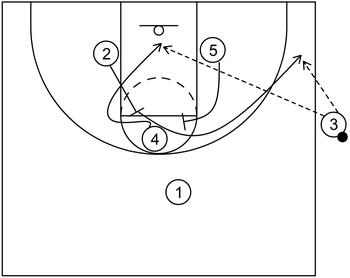
Next, 4 cuts to the basket via a back screen set by 2 near the high post area. Immediately following that, 2 cuts to the right side corner via the screen set by 5.
From there, if the team needs to score two points, then 4 could receive the ball from 3, preferably as a lob pass over the top of the defense, which could then lead to a possible alley-oop dunk.
On the other hand, if the team needs to score three-points, then 2 could receive the ball from 3 and take the three-point jump shot near the corner.